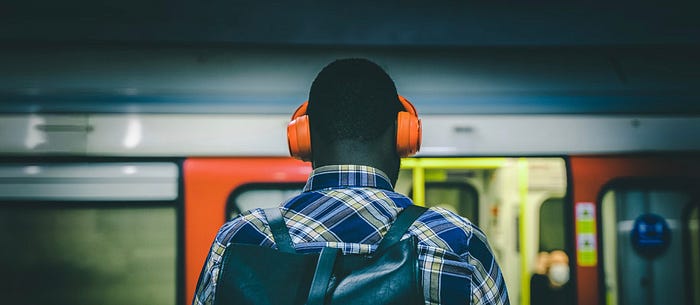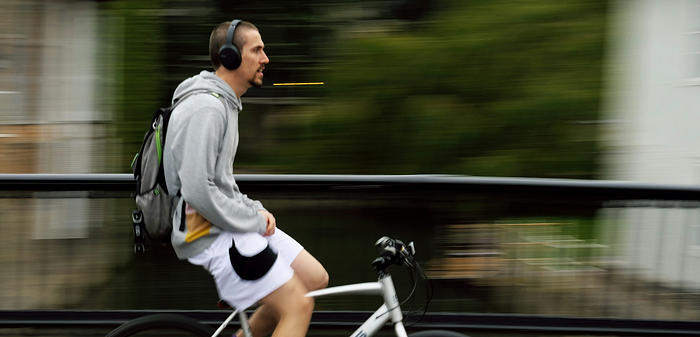Over-Ear Pandemic: How Headphones Isolate Us - and How To Reconnect
It starts with a playlist. Or a podcast. Something to fill the silence of a morning commute or make a walk through the city less mundane.
But as we slip on our over-ear headphones, tuning into our private soundtracks, we might be tuning out something far greater - connection, safety, and the serendipity that makes life vibrant.

Photo by Andrea De Santis on Unsplash
The Rise of a Soundtrack Society
Over-ear headphones weren't always a staple of everyday life.
They were once the domain of DJs, audiophiles, or the occasional office worker seeking focus.
Today, with a steady adoption over the past decade wireless noise cancelling headphones have become a ubiquitous accessory, promising to drown out the chaos of the world with curated soundscapes.
Public spaces, once alive with chance encounters and spontaneous conversations, are now seas of silent individuals cocooned in their (audio) bubbles - in an ever polarised world. The more we isolate ourselves with headphones, the more we risk losing the serendipity that makes public life so rich.
My personal observations give me the impression that in the past (post-Covid - and before) I experienced more serendipitous moments in public spaces. Nowadays, with the abundance of headphones and smartphones I somehow get to talk mostly elderly people that are still exposed to public without their digital shields. Is this a broader observation?
The Isolation Epidemic: From COVID to Headphones
The COVID-19 pandemic exacerbated this shift.
Social distancing and remote work normalised isolation, making it easier to retreat into private spaces - even in public.
Digital communication became the default, blurring the lines between genuine connection and parasocial interactions with voices on a podcast or streaming platform.
Wearing headphones in public became an extension of this trend, a way to shield ourselves from an unpredictable world. But this shielding comes at a cost. Research shows that face-to-face social interactions are crucial for mental health, community building, and learning. A study by Stav Atir and colleagues "Talking with strangers is surprisingly informative" reveals that people dramatically underestimate how much they can learn from talking to strangers - until they do**.** By wearing headphones, we preemptively close the door to these opportunities.

Photo by Grant Sams on Unsplash
Over-Ear Headphones in Traffic: When Isolation Turns Dangerous
This headphone pandemic isn't just a matter of lost social connections - it's a question of safety, particularly for cyclists. In countries like Spain, authorities have banned the use of headphones on bicycles altogether, citing safety concerns. Cyclists, after all, rely on auditory cues - like the honk of a car or the ding of a bell - to navigate busy streets.
But this rule sparks debate. Drivers, who are often enclosed in vehicles blasting music or podcasts, aren't held to the same standard. Should cyclists be denied the chance to spice up their rides with audio content?
A fair compromise would be the use of a single earbud, allowing cyclists to enjoy music or podcasts while keeping one ear open to the world around them. It's a solution that prioritizes safety without sacrificing enrichment.
My Hack: Reclaiming Serendipity in a Headphone-Dominated World
Beyond the road, over-ear headphones create another kind of barrier: one that separates us from the people around us. Spontaneous conversations on trains or in parks are becoming increasingly rare. Yet these moments of connection are often the most memorable - and meaningful.
By keeping one ear free, I've rediscovered the joy of serendipity.
Positive side-effect: This also helps you with only damaging one ear at a time and makes sure at least one earbud always has enough battery left
For example sitting on a train, I'll wear my earbud on the side facing the window, signaling to fellow passengers that I'm open to interaction. This small gesture has led to book recommendations, travel tips, and even friendships. Research backs up these experiences: conversations with strangers are often unexpectedly enriching, offering new perspectives and opportunities that we can't anticipate.
The Art of Mindful Listening
Christian Busch, in his book The Serendipity Mindset, argues that serendipity isn't just luck - it's a skill. By staying open to unexpected moments, we can turn the seemingly random into opportunities for growth, creativity, and connection. But this requires mindfulness.
Headphones aren't inherently bad. They're tools that offer focus and entertainment. But like any tool, they should be used with intention.
Maybe that means pausing the music when crossing a busy street, removing the headphones when sitting in a café, or simply wearing one earbud instead of two.
A podcast episode that really inspired me (Gut zuhören, besser verstehen – Wie Kommunikation gelingt - in German) told about the story of Alexander Stotkiewitz, who started working for the telephone counseling service after an experience of serindipious conversation where him listening to the sufferings of a Syrian refugee in Greece prevented this person from committing suicide. Stotkiewitz concluded that he might be good at listening and might be able to help more people.
These small shifts can help us reconnect with the world - and with each other.
A Call to Reconnect
The over-ear pandemic reflects a deeper societal trend: our desire to control our environments and shield ourselves from the unpredictable. But in doing so, we risk losing the beauty of that unpredictability.
Life is noisy and chaotic, yes. But it's also alive, full of unexpected conversations, moments of learning, and opportunities to connect. By choosing to keep one ear open - literally and metaphorically - we can break free from our own bubbles and reclaim the serendipity that makes life richer - and finally, grow closer together as a society.
Because in the end, the best soundtrack isn't the one we curate for ourselves. It's the one we stumble upon when we let the world in.
Sources that inspired me to tap into this topic
- My own observations as a digitally polluted kid who as a result of concern towards broader societal effects started to get exposed to topics such as digital literacy, society and technology
- Christian Busch (2020) _The Serendipity Mindset: The Art and Science of Creating Good Luck
_Explores how cultivating serendipity can create opportunities in daily life, emphasizing the importance of staying open to unexpected moments. View the book - Emi Sim (2024) - _Wireless Headphones Disconnect Social Interactions Among Teens
_Discusses the social and psychological impacts of wireless headphones on teens and their role in reducing social engagement. Read the article - Mackenzie Bengtsson (2024) "Noise-cancelling headphones might just be ruining our social lives". Read the article
- Dorothy Windham (2019) "The Lonely World of Earbuds" Read the article
- Wireless Headphones Market Analysis (2024) - Explores the rapid growth of the wireless headphone market, highlighting trends in adoption and technological advancements. Access the report
Headphones serve different purposes for everyone - some use them to focus or enjoy music, others to cope with sensory overload or avoid unwanted interactions. While they offer personal benefits, they can unintentionally create barriers to connection, safety, and serendipitous moments.
The challenge is finding a balance between enjoying their advantages and staying open to the world around us.
What about you? Do you feel headphones enhance or limit your experiences in public spaces? How do you balance personal space with staying connected to others?
🎧 Curious to dive deeper?
The BBC World Service featured this topic in their recent documentary "Living in a Bubble: The Headphone Revolution", where I also got to share some thoughts.
Listen to the full episode at BBC "The Documentary" or tune in live on BBC World Service on April 10 2025.
#Society #Attention #Serendipity #Technology